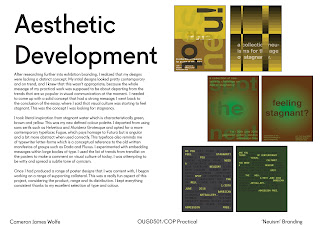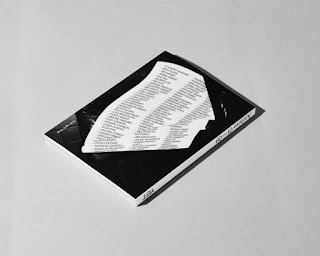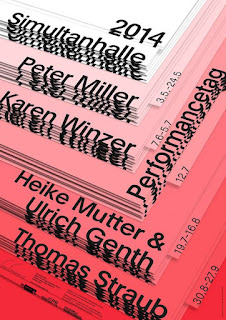OUGD501 –
Evaluation
I have very much enjoyed working
on COP2 this year, I feel I now value the more academic structure of the
Context of Practice module much more as it has given me opportunity to revisit
the critical thinking and academic writing in new, more focused and
refined contexts. I have found the COP2 module significantly more
rewarding than the first year COP1 module, as I have been more actively engaged
and focused with the area of research and inquiry. Choosing my own research
focus made the process and response to the module far more informed and rewarding,
and I especially enjoyed working on the practical aspect and tailoring it to my
current design interests and concerns. COP2 has extended my knowledge of many
significant movements that have impact contemporary visual culture, namely
postmodernism. This area of research interests me greatly and I have been
applying this inquiry across my other academic work within college and my
personal endeavours outside of my education.
My research question built on an area of
specific interest that I started to develop in my foundation year at
Central Saint Martins. For my final project there, I investigate hypermedia’s
and image saturated visual cultures and the impacts that they are having on
wider creative practice. At that stage, I was really undertaking in depth
contextual, academic research, all of my investigation was rooted in fine art
practice. COP2 provided me with a platform to really delve deeper into related topics,
exploring issues that I looked at very briefly in COP1. I was able to tailor my
investigation to my current interests and concerns within graphic design, which
I found really exciting. In level 04, I researched postmodernism in a very
broad sense. I knew that I wanted to research further into this fascinating
topic. I briefly touched on contemporary visual culture, looking at new wave
aesthetics and underground movements such as post-internet art and VaporWave
aesthetic, but I didn’t really feel satisfied with the level of analysis and
research, so I decided to carry on down these lines of investigation for COP2. I
looked into theories surrounding simulacrum and simulation last year, which was
beneficial. These theories can be used to explain and understand current trends
and attitudes within visual culture, so I saw it appropriate to explore them in
a more critical, contextual way. Through reading important academic sources,
including Baudriallard’s 1981 ‘Simulacra and Simulation’ and Jameson’s 1991 Postmodernism,
or the Cultural Logic of Late Capitalism, I was able to gain a more intellectual
insight into issues surrounding postmodernism and contemporary visual culture. My
broad contextual research into these key theorists and varied visual research allowed
me to develop a very strong essay structure. I found it easy to write a
conclusion, but found it challenging to take the research topics forward to
articulate them into a body of practical work.
I struggled for a long time to form
synthesis between the very broad, abstract and quite intangible issues being
discussed into a practical body of experimental visual work. I concluded in the
essay that contemporary visual culture has become, for want of a better word,
stagnant. I didn’t simply arrive at that conclusion based on personal views or
attitudes. My conclusion was supported by key theoretical statements from
poignant figures such as Baudrillard and Hutcheon, who were making observations
about trends in visual culture in the 1970's and 80's. I found it fascinating
that their investigations into this topic produced theories that seem to
predict and foreshadow our current creative/visual culture. Importantly, I
didn’t conclude that we have arrived at a state of pure simulacrum, nor have we
entered into a total hyper-reality. The majority of commercial visual
communication today is just that: commercial. Aesthetics here feel
polished, sophisticated, but there are definite elements of
expression and experimental attitudes that are prevalent in postmodern
work that seem to have become popular, especially amongst graphic
designers. What I found interesting was to look more closely at personal
work produced by contemporary creative's, to see the wider impacts that
they are having on visual culture. I concluded that visual culture has started
to feel stagnant in the sense that things have been done before in terms of
surfaces. It's as if designers are taking post-modernist principles and
attitudes and amplifying them beyond recognition. Therefore, I realised that my
practical work needed to attempt to make a comment on the state that
I personally feel we are experiencing and potentially offer some hope
for the future. The practical work in a sense, attempts to answer the issues
highlighted in the essay, providing a solution to the bold conclusion that I
came to.
Overall, COP has rewarded me in a number
of intellectual, academic, contextual, conceptual ways. This module has
been rewarding in the sense that it has encouraged me to forge new
connections between theoretical and creative practice within areas of visual
communication that I am passionate about. COP 2 has ultimately allowed me to
establish new links between the theory and practice of my personal
and professional work. Developing a research topic I have been completely
engaged with has resulted in a contextually relevant research essay that
has then been extended with thorough, well informed synthesis into a body
of contemporary practical work that I am very proud of.

























































